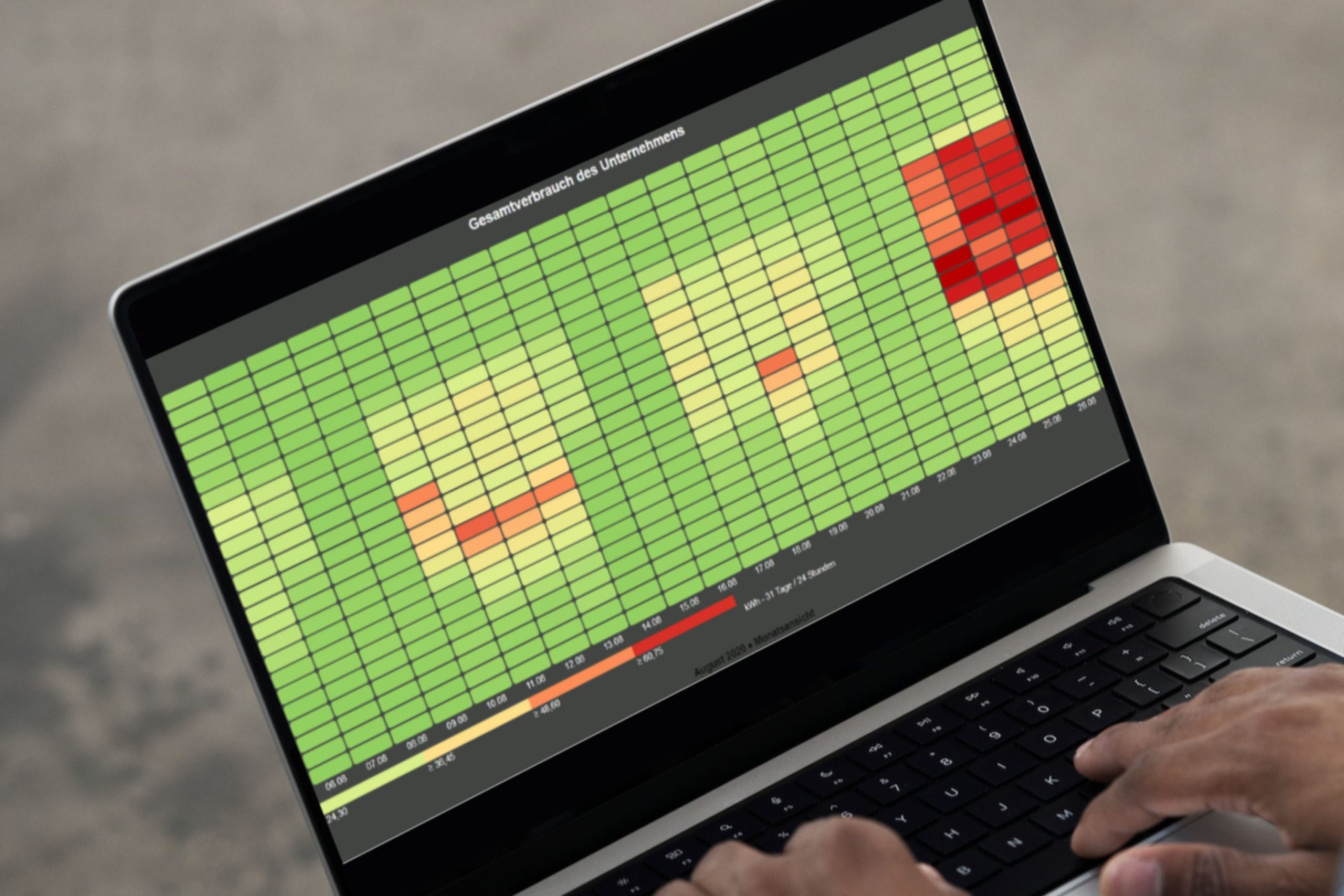Atypical grid usage.
Atypical grid usage is an instrument of the Federal Network Agency that enables industry, as the end consumer, to make considerable cost savings when purchasing power. To apply for this, the end consumer must comply with certain requirements, which can be met with just a few interventions using peak load optimization. This creates a win-win situation for trade and industry, as well as for the grid operators, who can utilize their grids more efficiently.
The article is also available as a PDF for download.
Background knowledge: Energy consumption and generation
Energy consumption in Germany varies considerably over the course of the day. There are peak times when energy consumption is significantly higher, for example in the morning or late afternoon, compared to quieter times at night or midday. These peak times are referred to as peak load times. The following diagram illustrates the average performance curve of all industrial load profiles in Germany. The high load on the grids is particularly evident between 9 am and 12 am and between 4 pm and 6 pm. However, each grid operator has its own peak load times, which may deviate from this general pattern.

During peak load times, energy suppliers have to provide large energy capacities. This is done by switching specially installed generation plants on and off, which are only used at peak load times. Otherwise, they are on standby for most of the time as capacity that can be switched on. It must also be possible to transmit the required power at all times, meaning that the necessary grid expansion would pose a major challenge for the grid operator. Due to the high costs involved, the question arises: How can energy suppliers and grid operators persuade industry to reduce its consumption at certain peak load times?
The benefits of atypical grid usage
The answer first of all: a financial incentive is created, a saving for the companies. This is also the case with atypical grid usage. This is because an electricity bill includes, among other things, billing according to the energy price, levies, charges and the demand charge (also: demand price). This demand charge is generally payable on the highest 15-minute value of a year. In the case of atypical grid usage, this performance price is not calculated on the highest value of the year, but on the highest value within the peak load window. High savings can therefore be achieved by specifically controlling your own consumption behavior during these periods.
What needs to be considered?
The highest value for atypical grid usage must therefore be outside the specified peak load times, i.e. atypical. These peak load times are therefore defined as peak load time windows and differentiated according to the time of year and withdrawal grid level. In the following example from Stadtwerke Schwabach for 2024, the peak load time windows for low voltage are between 16:45 and 18:30 in winter and between 17:15 and 18:15 in fall. A company in this grid area only has to reduce its power consumption from the grid during these few hours of the year in order to be able to apply for atypical grid usage.

In addition to the peak load time windows, which change from year to year, certain thresholds must also be reached. These are defined in a materiality threshold, a minimum shift and a de minimis threshold and depend on the customer’s grid level. This means, for example, that in the low-voltage grid, industrial customers must reduce their peak demand in the peak load time windows by at least 30% (materiality threshold) and by 100 kW (minimum shift) and achieve a saving of €500 (de minimis limit). These values refer in each case to the difference between the 15-minute value of the total annual power peak and the 15-minute value of the power peak in the peak load time windows of a calendar year.

In brief: The peak power value in the peak load time window must be lower by these thresholds than in the times outside the peak load time window. If the requirements are met, only the lower peak value of the peak load time window is used to calculate the demand charge. It is therefore advisable to apply for atypical grid usage if it is realistic that these thresholds can be met. If these are not automatically met, energy optimization can be used to intervene in operation and apply for atypical grid usage.
As the peak load time windows are precisely defined for 12 months, it is all the easier to reduce the power peak in just a small time window per day and achieve (high) savings.
Implementation through the intervention of energy optimization at KBR
At KBR, atypical grid usage is solved by the intervention of the intelligent multimax energy optimization system. For this purpose, the load profile of the previous year was first considered, in which the thresholds were not met and therefore no individual grid charge could be applied for. First, the consumers with the highest output within the peak load time window were searched for. These consumers were output using a standard report from the energy data management system visual energy. This is because the system’s flexibly configurable reporting system made it possible to determine the highest consumers in the peak load time window at the touch of a button. This revealed that the minimum shift of 100 kW could only be achieved by postponing the drying process of an energy-intensive industrial oven to before 12 noon so that it was completed at the start of the peak load time window at 4:45 pm. It was also necessary to intervene in the heating control system by reducing the flow temperature of the heat pump for the duration of the peak load window.
Other consumers that could cause peaks in the peak load time window were the e-charging stations. The charging current of these has already been reduced in operation for years by the interaction of the automatically regulating multimax energy optimization system and a battery storage unit, depending on requirements. This provided the basis for flexibly shifting the relevant consumers in operation.
Finally, a target value was defined in the energy optimization, which must not be exceeded and is always maintained by switching off the above and other loads. If the switch-off potential is not sufficient, a battery storage system is charged by the automatic control system at the start of the high load time window so that it can intervene if necessary.
Atypical grid usage is now monitored twice. Once in the intelligent energy optimization system multimax and additionally in the energy data management system visual energy (see Figure 4).

How high are the savings?
In the diagram above, a simple rule of three immediately shows how high the savings are for a power price of 108 €/kwh/a:
Annual power peak:
207 kWh x 108 €/kWh/a = 22.356 €/a
Peak load time window power peak:
65 kWh x 108 €/kWh/a = 7.020 €/a
Savings
= 22.356 €/a – 7.020 €/a = 15.336 €/a
By offsetting the power peak of the high-load time window, KBR will save over €15,000 per year, meaning that the purchase of the multimax energy optimization system will have paid for itself in the first year. If the consumers to be switched off are known, for example through an analysis in the visual energy energy data management system, it is recommended that intelligent energy optimization be used,
as this energy optimization, as this can actively control the consumers and intervene.
If the shift in the power peak is well over 100 kW, the savings through the use of atypical grid usage increase significantly.
Conclusion
Atypical grid usage is a simple and efficient way for companies to reduce the cost of the demand charge. As the minimum shift in atypical grid usage cannot usually be achieved without further ado, it makes sense to purchase an intelligent energy optimization system. The optimization experts at KBR will be happy to help you with this. We look forward to your questions so that we can support you.
Your Simon Tempelmeier
Product Management
KBR GmbH











